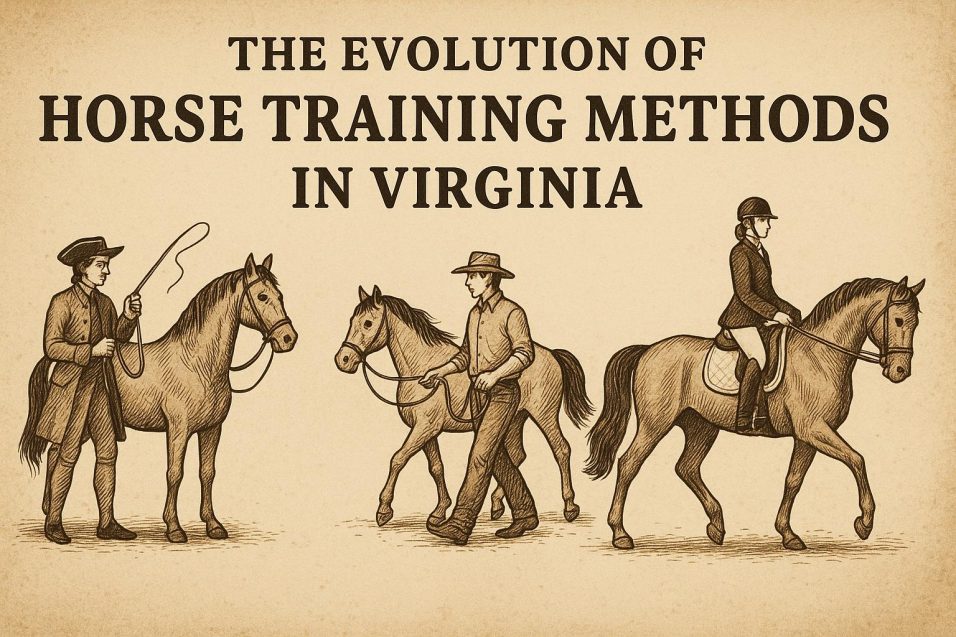The Evolution of Horse Training Methods in Virginia
The history of horse training in Virginia offers a unique perspective on the development of equestrian practices influenced by broader changes in the agricultural sector, technological innovations, and cultural transformations. Tracking the evolution of these methods reveals insights into the adaptability and advancement of training techniques, from simple beginnings to highly sophisticated approaches. This article delves into the pivotal moments and elements that have shaped horse training in Virginia over time.
Early Methods and Agricultural Focus
At the dawn of Virginia’s settlement, horses were indispensable to both agriculture and transportation. The rural community’s reliance on horse power meant training was largely dictated by practical necessity. Dominated by a utilitarian approach, the early methods of horse training in Virginia were designed to meet the demands of fieldwork and transport. During this time, horses needed to be robust and resilient, capable of plowing fields and pulling heavy loads. Training, therefore, was characterized by a focus on basic commands and building up the animals’ strength and stamina. This straightforward training involved repetitive routines to instill obedience and reliability.
Influence of European Practices
As Virginia’s ties with Europe strengthened, the incorporation of European horse training techniques became inevitable. By the 18th and 19th centuries, this transatlantic influence was manifest in the region. European trainers, skilled in the art of dressage and cavalry maneuvers, introduced a new dimension to horse training in Virginia. Training began to extend beyond fundamental tasks, with an emphasis on discipline, precision, and the elegance of a horse’s movement. This marked a paradigm shift, illustrating a blend of functionality with the aesthetic appeal of equestrian performance, mirroring the evolution from mere practicality to an art form.
Racing and the Rise of the Thoroughbred
The 19th century heralded the meteoric rise of horse racing in Virginia, fundamentally reshaping training methodologies. The introduction of the Thoroughbred breed into the American equestrian landscape necessitated a recalibration of training techniques to focus on maximizing speed and endurance. Thoroughbreds required a specialized training regimen that was tailored to fine-tune racing capabilities. During this era, scientific advancements began to permeate the training process, bringing a strategic perspective that incorporated aspects of nutrition and veterinary science. Trainers engaged in meticulous planning and made informed decisions about diet, fitness routines, and conditioning strategies, all aimed at optimizing the performance and health of these prized racers.
Modern Approaches and Technological Integration
The 20th century marked the beginning of a technological transformation in horse training practices within Virginia, as worldwide advances began to impact the local equestrian community. Today, cutting-edge technologies have been harmonized with traditional techniques, enhancing the precision and effectiveness of training programs. Modern horse training facilities in Virginia embrace innovations such as video analysis, which allows trainers to study and refine movement intricacies in detail. Biometrics and other technological tools provide data-driven insights into a horse’s physical condition, enabling adjustments to training regimens that optimize performance while safeguarding health.
Incorporation of Behavioral Science
A significant evolution within contemporary horse training practices involves the growing emphasis on behavioral science. Recent approaches have pivoted toward more humane and ethical methods, reflecting a deeper understanding of equine psychology and welfare. Modern trainers are integrating principles of behavioral science to foster a positive training environment, prioritizing the mental well-being of horses alongside physical conditioning. Techniques grounded in positive reinforcement, such as rewards and praise, are employed to encourage desirable behaviors. This approach builds a foundation of trust and collaboration between horse and trainer, promoting a more humane and efficient training process.
Links to Further Resources
For further exploration of horse training methods and historical context, resources provided by the [Virginia Horse Industry Board](https://www.vhib.org) and the [American Horse Council](https://www.horsecouncil.org) can offer valuable insights. These organizations provide educational materials, updates on developing trends, and opportunities for involvement in horse care and management initiatives, suitable for both newcomers and seasoned professionals.
Conclusion
The trajectory of horse training methods in Virginia provides a case study in the fusion of local practices with international influences. Throughout each era, training techniques have adapted to meet evolving economic demands, leveraging technological progress while maintaining a commitment to the welfare of horses. Moving forward, it remains crucial to strike a balance between traditional insights and contemporary innovations, ensuring that training methodologies continue to progress in a manner that prioritizes both the performance and the well-being of horses. As the equestrian field continues to evolve, the stewardship and dedication to equine welfare demonstrated by past generations in Virginia will remain a guiding influence for future advancements in horse training practices.


